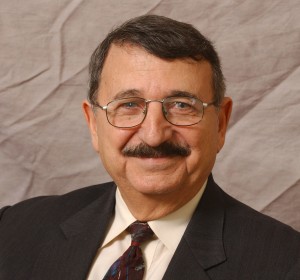Inaugural Student Selected VINSE Keynote Address
Dr. Mostafa A. El-Sayed
Julius Brown Chair and Regents Professor
Department of Chemistry and Biochemistry
Director, Laser Dynamics Lab
Georgia Institute of Technology
“Nano-Technology Meets Biology in the Cancer Cell”
Abstract: Using biochemical-targeting methods, one can conjugate the plasmonic nanoparticles to many parts of the cell, healthy or sick. Since the nanoparticles have comparable size to many parts of the cell, binding plasmonic (or nonplasmonic) nanoparticles to parts of the cell could change its properties including curing, or, most likely, killing sick cells. Using plasmonic nanoparticles has the advantage of using their enhanced scattering properties to image the response of the cells1-3 (including death) to the effect of binding the nanoparticles to selected part of the cell. Not only one can image the response of the cells directly bound to the nanoparticles but also the reaction of the community of the surrounding nanoparticle-free cells In order to gain intra-cell molecular information, and thus molecular cell mechanisms instead of just global cell information, we were recently able4 to record the enhanced molecular Raman vibration spectra (SERS) of molecules anywhere in the cell during the full cell cycle, from birth to division. Furthermore, if we give the cells cancer drugs, we can determine the time of the cell death, i.e. we can determine drug efficacy. The potential future applications of this technique of Targeted Plasmonically Enhanced Single Cell Imaging Spectroscopy (T-PESCIS) in molecular cell biology, in drug testing5, in determining drug action and cell death mechanisms will be pointed out.
References:
(1) Kang, B.; Mackey, M. A.; El-Sayed, M. A. J. Am. Chem. Soc Comm. 2010, 132, 1517
(2) Austin, L.; Kang, B.; Yen, C.-W.; El-Sayed, M. A. J. Am. Chem. Soc. Comm. 2011, 133, 17594.
(3) Austin, L. A.; Kang, B.; Yen, C.-W.; El-Sayed, M. A. Bioconjugate Chem. 2011, 22, 2324.
(4) Kang, Bin; Austin, Lauren A. and El-Sayed, Mostafa A.; Real-Time Molecular Imaging throughout the Entire Cell Cycle by Targeted Plasmonic-Enhanced Rayleigh/Raman Spectroscopy, Nano Lett., 2012, 12 (10), pp 5369–5375.
(5) Austin, L.; Kang, B.; Yen, C.-W.; El-Sayed, M. A. A New Nanotechnology Technique for Determining Drug Efficacy Using Targeted Plasmonically Enhanced Single Cell Imaging Spectroscopy. JACS comm, 2013, 135 (12), 4688-4691.
Graduate Student Seminar Committee:
Kyle Zufelt (Interdisciplinary Materials Science), Committee Chair
Kelsey Beavers (Interdisciplinary Materials Science)
Hiram Conley (Physics)
Amy Ng (Chemistry)